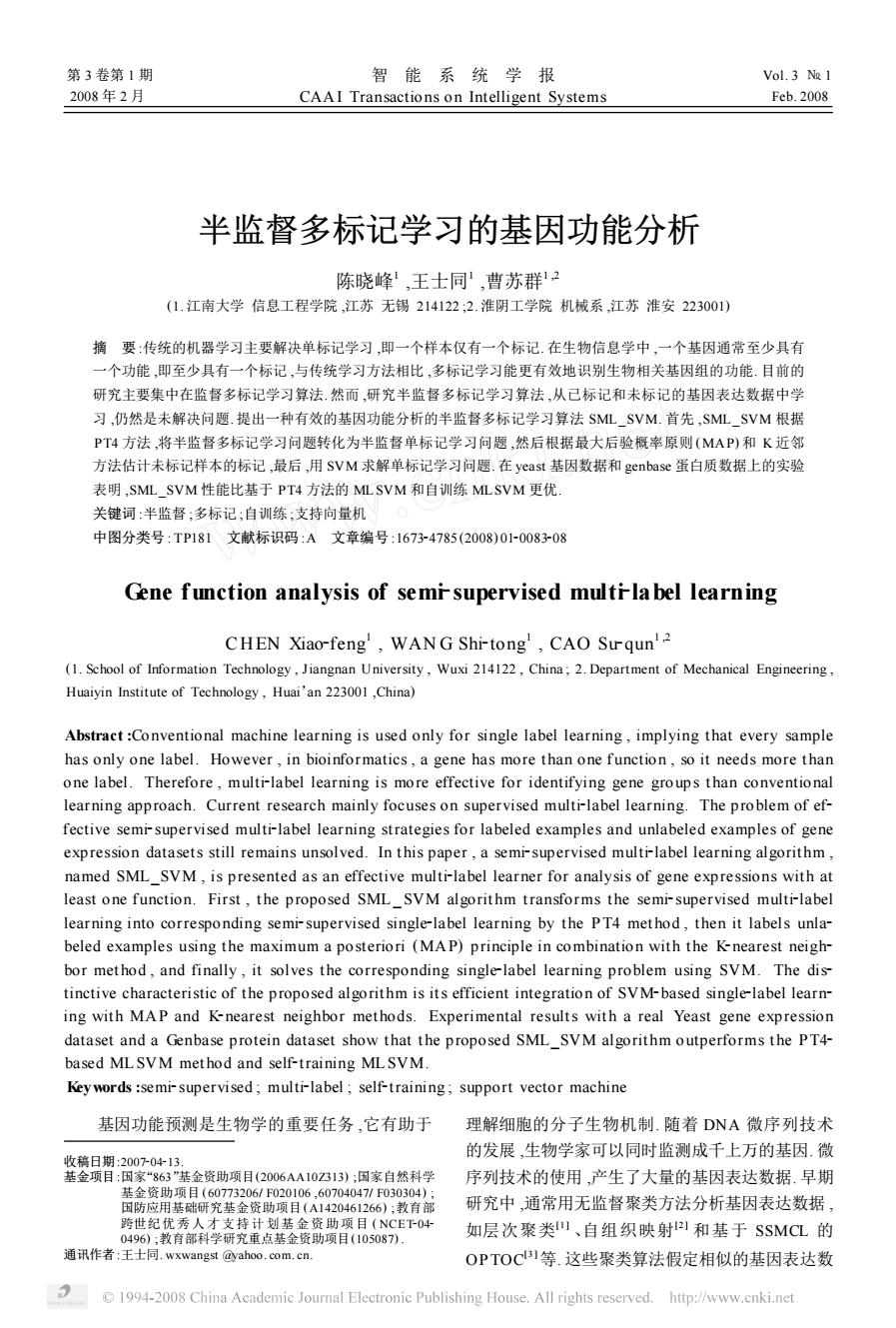正在加载图片...

第3卷第1期 智能系统学报 Vol.3 Ne 1 2008年2月 CAAI Transactions on Intelligent Systems Fcb.2008 半监督多标记学习的基因功能分析 陈晓峰,王士同,曹苏群2 (1.江南大学信息工程学院,江苏无锡214122:2.淮阴工学院机械系,江苏淮安223001) 摘要:传统的机器学习主要解决单标记学习,即一个样本仅有一个标记.在生物信息学中,一个基因通常至少具有 一个功能,即至少具有一个标记,与传统学习方法相比,多标记学习能更有效地识别生物相关基因组的功能.目前的 研究主要集中在监督多标记学习算法.然而,研究半监督多标记学习算法,从已标记和未标记的基因表达数据中学 习,仍然是未解决问题.提出一种有效的基因功能分析的半监督多标记学习算法SML SVM.首先,SML SVM根据 PT4方法,将半监督多标记学习问题转化为半监督单标记学习问题,然后根据最大后验概率原则(MAP)和K近邻 方法估计未标记样本的标记,最后,用SVM求解单标记学习问题.在yeast基因数据和genbase蛋白质数据上的实验 表明,SML_SVM性能比基于PT4方法的MLSVM和自训练MLSVM更优 关键词:半监督;多标记;自训练,支持向量机 中图分类号:TP181文献标识码:A文章编号:16734785(2008)01-008308 Gene function analysis of semi supervised multi-la bel learning CHEN Xiao-feng',WANG Shi-tong',CAO Surqun'2 (1.School of Information Technology,Jiangnan University,Wuxi 214122,China;2.Department of Mechanical Engineering, Huaiyin Institute of Technology,Huai'an 223001,China) Abstract:Conventional machine learning is used only for single label learning,implying that every sample has only one label.However,in bioinformatics,a gene has more than one function,so it needs more than one label.Therefore,multi-label learning is more effective for identifying gene groups than conventional learning approach.Current research mainly focuses on supervised multi-label learning.The problem of ef- fective semi-supervised multi-label learning strategies for labeled examples and unlabeled examples of gene expression datasets still remains unsolved.In this paper,a semi-supervised multi-label learning algorithm, named SML_SVM,is presented as an effective multi-label learner for analysis of gene expressions with at least one function.First,the proposed SML_SVM algorithm transforms the semi-supervised multi-label learning into corresponding semi-supervised single-label learning by the PT4 method,then it labels unla- beled examples using the maximum a posteriori(MAP)principle in combination with the K-nearest neigh- bor method,and finally,it solves the corresponding single-label learning problem using SVM.The dis- tinctive characteristic of the proposed algorithm is its efficient integration of SVM-based single-label learn- ing with MAP and K-nearest neighbor methods.Experimental results with a real Yeast gene expression dataset and a Genbase protein dataset show that the proposed SML_SVM algorithm outperforms the PT4- based MLSVM method and self-training MLSVM. Keywords:semi-supervised;multi-label;self-training;support vector machine 基因功能预测是生物学的重要任务,它有助于理解细胞的分子生物机制.随着DNA微序列技术 收稿日期:2007-0413. 的发展,生物学家可以同时监测成千上万的基因.微 基金项目:国家“863”基金资助项目(2006AA10Z313):国家自然科学 序列技术的使用,产生了大量的基因表达数据.早期 基金资助项目(60773206/F020106,60704047/F030304): 国防应用基础研究基金资助项目(A1420461266);教育部 研究中,通常用无监督聚类方法分析基因表达数据, 跨世纪优秀人才支持计划基金资助项目(NCE下O4 0496);教育部科学研究重点基金资助项目(105087). 如层次聚类四、自组织映射)和基于SSMCL的 通讯作者:王士同.wxwangst@yahoo.com,cn. OPTOC!)等.这些聚类算法假定相似的基因表达数 1994-2008 China Academic Journal Electronic Publishing House.All rights reserved.http://www.cnki.net第 3 卷第 1 期 智 能 系 统 学 报 Vol. 3 №. 1 2008 年 2 月 CAA I Transactions on Intelligent Systems Feb. 2008 半监督多标记学习的基因功能分析 陈晓峰1 ,王士同1 ,曹苏群1 ,2 (1. 江南大学 信息工程学院 ,江苏 无锡 214122 ;2. 淮阴工学院 机械系 ,江苏 淮安 223001) 摘 要 :传统的机器学习主要解决单标记学习 ,即一个样本仅有一个标记. 在生物信息学中 ,一个基因通常至少具有 一个功能 ,即至少具有一个标记 ,与传统学习方法相比 ,多标记学习能更有效地识别生物相关基因组的功能. 目前的 研究主要集中在监督多标记学习算法. 然而 ,研究半监督多标记学习算法 ,从已标记和未标记的基因表达数据中学 习 ,仍然是未解决问题. 提出一种有效的基因功能分析的半监督多标记学习算法 SML_SVM. 首先 ,SML_SVM 根据 PT4 方法 ,将半监督多标记学习问题转化为半监督单标记学习问题 ,然后根据最大后验概率原则 (MAP) 和 K 近邻 方法估计未标记样本的标记 ,最后 ,用 SVM 求解单标记学习问题. 在 yeast 基因数据和 genbase 蛋白质数据上的实验 表明 ,SML_SVM 性能比基于 PT4 方法的 MLSVM 和自训练 MLSVM 更优. 关键词 :半监督 ;多标记 ;自训练 ;支持向量机 中图分类号 : TP181 文献标识码 :A 文章编号 :167324785 (2008) 0120083208 Gene function analysis of semi2supervised multi2label learning CH EN Xiao2feng 1 , WAN G Shi2tong 1 , CAO Su2qun 1 ,2 (1. School of Information Technology , Jiangnan University , Wuxi 214122 , China ; 2. Department of Mechanical Engineering , Huaiyin Institute of Technology , Huai’an 223001 ,China) Abstract :Conventional machine learning is used only for single label learning , implying t hat every sample has only one label. However , in bioinformatics , a gene has more than one f unction , so it needs more than one label. Therefore , multi2label learning is more effective for identifying gene group s t han conventional learning approach. Current research mainly focuses on supervised multi2label learning. The problem of ef2 fective semi2supervised multi2label learning strategies for labeled examples and unlabeled examples of gene expression datasets still remains unsolved. In t his paper , a semi2supervised multi2label learning algorithm , named SML_SVM , is presented as an effective multi2label learner for analysis of gene expressions wit h at least one f unction. First , t he proposed SML _SVM algorit hm transforms t he semi2supervised multi2label learning into corresponding semi2supervised single2label learning by the PT4 met hod , t hen it labels unla2 beled examples using the maximum a posteriori (MAP) principle in combination wit h t he K2nearest neigh2 bor met hod , and finally , it solves t he corresponding single2label learning problem using SVM. The dis2 tinctive characteristic of t he proposed algorithm is its efficient integration of SVM2based single2label learn2 ing wit h MA P and K2nearest neighbor met hods. Experimental results wit h a real Yeast gene expression dataset and a Genbase protein dataset show that t he proposed SML_SVM algorit hm outperforms t he PT42 based ML SVM met hod and self2training ML SVM. Keywords :semi2supervised ; multi2label ; self2training ; support vector machine 收稿日期 :2007204213. 基金项目 :国家“863”基金资助项目(2006AA10Z313) ;国家自然科学 基金资助项目 (60773206/ F020106 ,60704047/ F030304) ; 国防应用基础研究基金资助项目(A1420461266) ;教育部 跨世纪优秀人 才支持计划基 金资助项目 ( NCET2042 0496) ;教育部科学研究重点基金资助项目(105087) . 通讯作者 :王士同. wxwangst @yahoo. com. cn. 基因功能预测是生物学的重要任务 ,它有助于 理解细胞的分子生物机制. 随着 DNA 微序列技术 的发展 ,生物学家可以同时监测成千上万的基因. 微 序列技术的使用 ,产生了大量的基因表达数据. 早期 研究中 ,通常用无监督聚类方法分析基因表达数据 , 如层次聚类[1 ] 、自组织映射[2 ] 和基于 SSMCL 的 OPTOC [3 ]等. 这些聚类算法假定相似的基因表达数